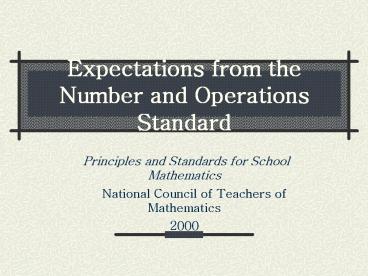Expectations from the Number and Operations Standard PowerPoint PPT Presentation
Title: Expectations from the Number and Operations Standard
1
Expectations from the Number and Operations
Standard
- Principles and Standards for School Mathematics
- National Council of Teachers of Mathematics
- 2000
2
Understand numbers, ways of representing numbers,
relationships among numbers, and number systems.
- Grades Pre-K-2
- Understand and represent commonly used
fractions, such as 1/4, 1/3, and 1/2.
3
Understand numbers, ways of representing numbers,
relationships among numbers, and number systems.
- Grades 3-5
- Develop understanding of fractions as parts of
unit wholes, as parts of a collection, as
locations on number lines, and as divisions of
whole numbers. - Use models, benchmarks, and equivalent forms to
judge the size of fractions. - Recognize and generate equivalent forms of
commonly used fractions, decimals, and percents. - Explore numbers less than 0 by extending the
number line and through familiar applications.
4
Understand numbers, ways of representing numbers,
relationships among numbers, and number systems.
- Grades 6-8
- Work flexibly with fractions, decimals, and
percents to solve problems. - Compare and order fractions, decimals, and
percents efficiently and find their approximate
locations on a number line.
5
Understand meanings of operations and how they
relate to one another.
- Grades 6-8
- Understand the meaning and effects of arithmetic
operations with fractions, decimals, and
integers. - Use the associative and commutative properties of
addition and multiplication and the distributive
property of multiplication over addition to
simplify computations with integers, fractions,
and decimals.
6
Compute fluently and make reasonable estimates.
- Grades 3-5
- Develop and use strategies to estimate
computations involving fractions and decimals in
situations relevant to students experience. - Use visual models, benchmarks, and equivalent
forms to add and subtract commonly used fractions
and decimals.
7
Compute fluently and make reasonable estimates.
- Grades 6-8
- Select appropriate methods and tools for
computing with fractions and decimals from among
mental computation, estimation, calculators or
computers, and paper and pencil, depending on the
situation, and apply the selected methods. - Develop and analyze algorithms for computing with
fractions, decimals, and integers and develop
fluency in their use. - Develop and use strategies to estimate the
results of rational-number computations and judge
the reasonableness of the results.
8
Fraction Connections
9
Decimal Connections
10
Fraction Letters
- Use one of each of the rods. Make an H with the
same number of rods in each vertical part and the
cross bar being one-fifth as long as the vertical
parts.
One possible solution gt
11
Interviewer, "Which fraction is more, 1/3 or
1/4? 2/5 or 2/7? Charles Fifth Month of Fourth
Grade
12
Interviewer, "Add these fractions. 3/8 2/8, 2/3
1/4. Amanda Fifth Month of Fourth Grade
13
Interviewer, "Add these fractions. 3/8 2/8, 2/3
1/4. Amy Fifth Month of Fourth Grade

